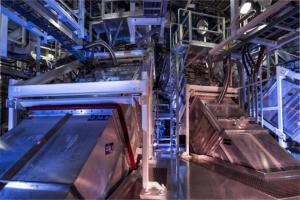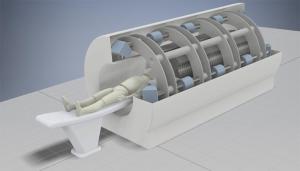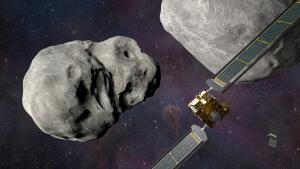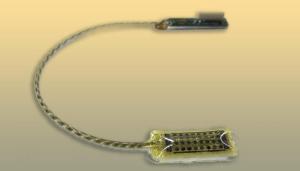LAB REPORT
Science and Technology Making Headlines
Dec. 10, 2021


Scientists at the National Ignition Facility are nearer to achieving ignition – the point at which fusion reactions generate at least as much energy delivered by the laser system.
A breakthrough of the year
2021 was a milestone for laser fusion. The National Ignition Facility’s giant laser experiment is nominated as one of 10 finalists for Physics World's 2021 Breakthrough of the Year.
This year’s Top 10 breakthroughs were selected by a crack team of five Physics World editors, who have sifted through hundreds of research updates published on the website this year. In addition to having been reported in Physics World in 2021, selections must meet the following criteria:
- Significant advance in knowledge or understanding
- Importance of work for scientific progress and/or development of real-world applications
- Of general interest to Physics World readers


Superionic ice could be responsible for the odd, off-kilter magnetic fields in Uranus and Neptune, which have been puzzling scientists for years.
Cold as ice
As if the thought of scorching black ice isn’t weird enough, it now exists as a new state of matter.
It might already exist on Uranus, Neptune and possibly other planets that orbit alien stars. Just heat water to several thousand degrees while applying extreme pressure. Of course, this sounds easier than it actually is, but scientists from Lawrence Livermore, UC Berkeley and the University of Rochester were able to pull off creating this exotic state of H2O for the first time ever.
Exposing water to pressures and temperatures that high makes hydrogen ions (atoms that have gained or lost electrons) move like a liquid inside solid oxygen. LLNL physicist Marius Millot led a study that reveals exactly how he and his research team were able to create a state of matter that could only be imagined when it was first predicted back in 1988.
“Our experimental discovery of superionic water ice opens the way to imagining new kinds of water-rich planets with mostly frozen interiors,” Millot said. “It could dominate the interiors of Neptune and Uranus, which offers a plausible origin to their unique magnetic fields.”


An artist’s concept rendering of a 3.5-meter linear induction accelerator (LIA) with four lines-of-sight toward a patient. The blue elements magnetically focus and direct the LIA’s electron beams.
Cancer therapy in a FLASH
Researchers at Lawrence Livermore have shown for the first time the potential for linear induction accelerators (LIAs) to deliver effective, targeted doses of "FLASH" radiation to cancer patients. The new technique selectively kills cancer cells with minimal damage to healthy cells.
For decades, cancer treatment has often meant weeks of low-dose radiation in hopes of delivering enough to malignant cells without too much damage to the patient's healthy cells. Efforts to deliver a rapid, high, targeted dose of therapy radiation, or FLASH radiotherapy (FLASH-RT) at the required depth, have required large, complex machines the size of gymnasiums and have so far proven impractical for clinical use. The researchers note that LIAs powerful enough to deliver the necessary dose rate to cancer cells can be built only 3 meters long.
"You're combining technologies that were developed for weapons — either diagnostics or weapon design itself — and spinning off something that could potentially be a major breakthrough in cancer radiotherapy," said Laboratory scientist Stephen Sampayan.


Illustration of the Double Asteroid Redirection Test mission and its target, Dimorphos, a moonlet of the asteroid Didymos. Image courtesy of Steve Gribben /NASA/Johns Hopkins APL.
DARTing to an asteroid
Along with hundreds of others, Lawrence Livermore scientists are taking part in the Double Asteroid Redirection Test (DART) mission, an ambitious effort led by NASA to slam an uncrewed spacecraft into an asteroid to change its orbit. This is a dry run for the real deal: one day, a technological descendant of DART could be used to deflect a planet-threatening space rock, saving millions — perhaps billions — of lives in the process.
In late November, DART launched on a SpaceX Falcon 9 rocket from California’s Vandenberg Space Force Base. Sometime next fall, it will smash into its target at 24,000 kilometers per hour. Ground-based astronomers will watch the rendezvous unfold with bated breath, hoping to see the telltale signs of success: a dust cloud, and an asteroid dancing to humanity’s tune for the very first time. Will it work?
Didymos, nearly 800 meters across, is orbited by a moonlet, Dimorphos, which is 160 meters long. That little moonlet is DART’s target.
Megan Bruck Syal, a planetary defense researcher at the Lawrence Livermore National Laboratory, has repeatedly simulated its fated impact. “On the surface, the DART experiment seems really simple,” she said. But only one thing is certain: no outcome is assured, because so many of Dimorphos’s fundamental properties remain unknown.


A LLNL and University of California, San Francisco team of researchers found that the flexibility of LLNL-developed thin-film microelectrodes, combined with higher-density grid spacing, provides greater levels of detail about how the brain works.
Taking a look at the brain in action
Earlier this year, thin-film microgrid arrays developed at Lawrence Livermore and used in neurologist Jon Kleen's patients at the University of California, San Francisco (UCSF) showed that hippocampal brain activity consisted of waves that traveled bi-directionally during behavioral tasks. These thin-film microgrid arrays are designed not just to sit on the surface of the brain, as they did when measuring the hippocampal brain waves, but are flexible enough to make intimate contact with the topography of the brain's surface.
The researchers found that this flexibility, combined with higher-density grid spacing, provides greater levels of detail about how the brain works, while also providing the ability to stimulate areas of the brain affected by epilepsy and other neurological disorders.
The thin-film micro-electrocorticography surface arrays contain 32 electrodes, and are 1.2 mm in diameter, with a pitch (the distance between their centers) of just 2 mm, providing a higher level of spatial specificity and localization than commercial electrode arrays. Because the thin-film arrays' flexibility and size have the potential for adding dozens more electrodes to an array, the researchers argue that the manufacturing and assembly approach described shows great promise for acquiring unique information that will allow for customizable, refined spatial targeting of different areas of the brain — with implications for clinical and research applications, including intracranial stimulation.





